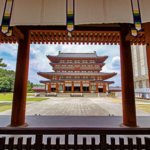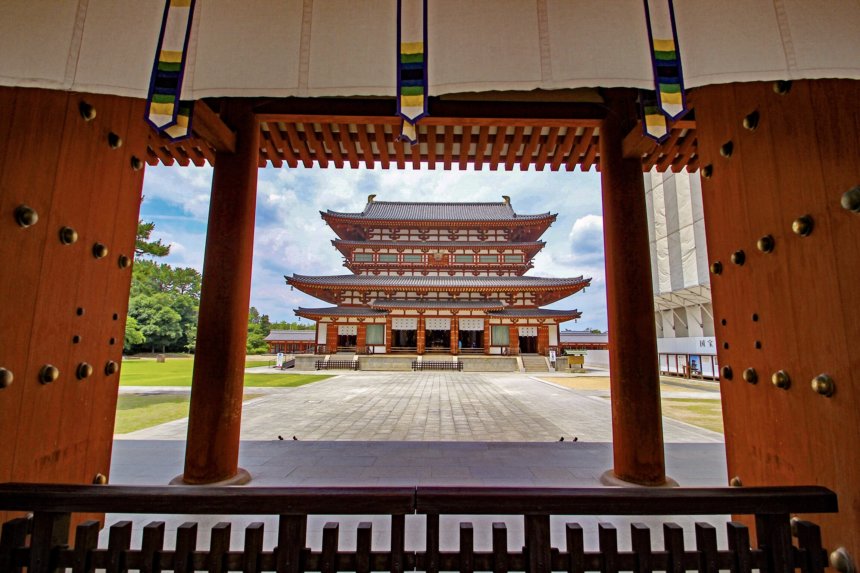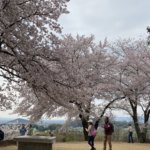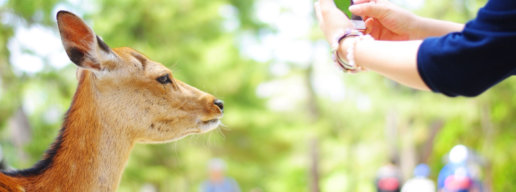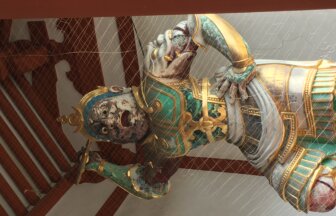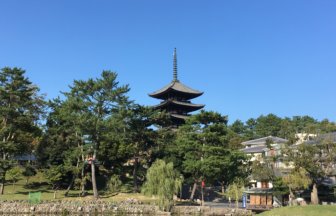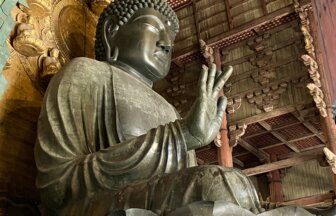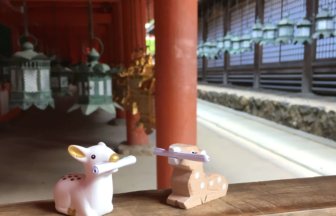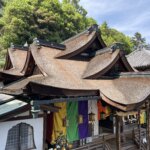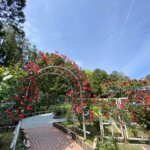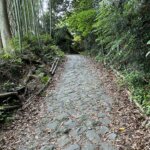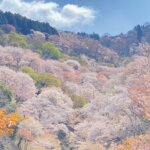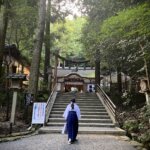Eye-catching photo by giuliettar2
Yakushi-ji is a large and magnificent temple located in the West Nara area.
Although its history dates back to 680, many of the buildings were reconstructed comparatively recently. The color vermilion is thought to have the power to expel evil spirits and is used in temples and shrines very often, but it easily fades away over the years. At Yakushi-ji, the color is still vivid on the columns, beams and doors and makes the temple very photogenic.
Its huge precincts are divided into two areas by the road that extends from Nishinokyo Station of the Kintetsu Railway to the east: Hakuho Precincts in the south (on the right) and Genjo Sanzo-in Precincts in the north (on the left). The majority of must-sees are located in the south.
Hakuho Precincts (in the South)
Main Hall (Kondo)
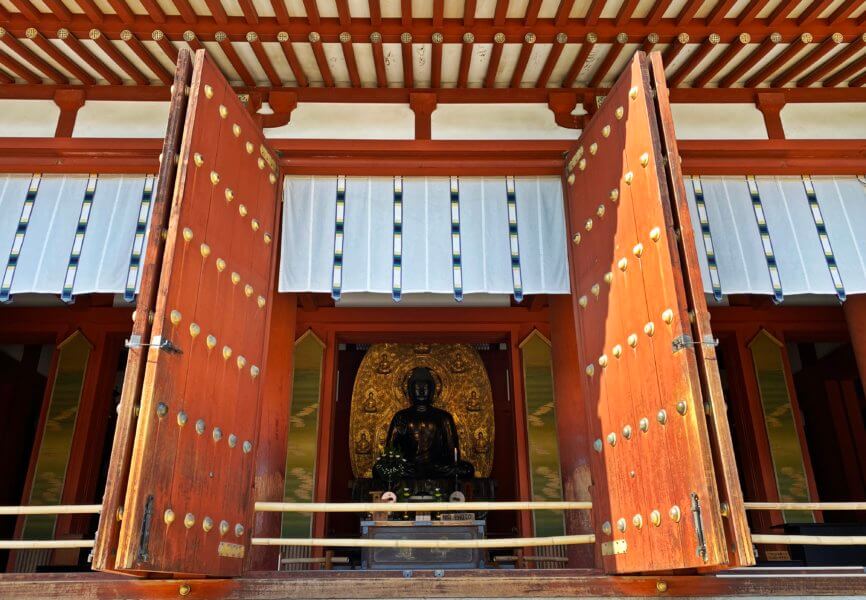
This is undoubtedly the highlight of Yakushi-ji Temple. Even before entering the Hall, you will notice the graceful figures of three Buddhist statutes through its open doors. They are Yakushi Nyorai (Buddha of Medicine), Nikko Bosatsu and Gakko Bosatsu — collectively called the Yakushi Triad. Yakushi Nyorai sits in the center, creating a dignified but calm atmosphere. Nikko and Gakko look young and genderless. They slightly bend the three parts of their bodies — necks, waist and knees — which is compared to the “contrapposto” posture of the famous ancient Greek statue, the Venus de Milo. The postures of Nikko on the right and Gakko on the left are symmetrical.
All have boat-shaped large golden halos on their backs, with delicate reliefs and small Buddhas on them. They are so bright that they evoke a feeling of awe.
All three bronze statues were created around the seventh to eighth century and are National Treasures.
Proceed to the back of the statues and you will find a small open door on the opposite side of the exit of the building. Look into it. You can see the back side of the pedestal of Yakushi Nyorai. It is the perfect integration of the cultures around the world in the eighth century.
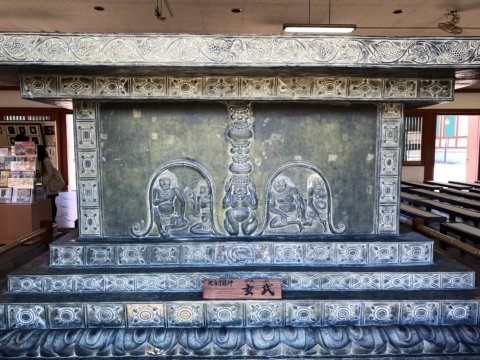
(Replica in the East Priests’ Quarter building)
On the top tier is a grapevine pattern from Greece. Below are lotus flowers from Persia. Depicted on the large rectangular surface between the top and bottom tiers are deities of power in India. In the center of the tier immediately below it (above the wooden plate in the photo above) is one of the deities of the four directions in China. It eloquently tells that Nara was the east end of the Silk Road.
Pictures of the Yakushi Triad (Official Yakushi-ji website)
https://www.yakushiji.or.jp/en/temples/004.html
Great Lecture Hall (Daikodo)
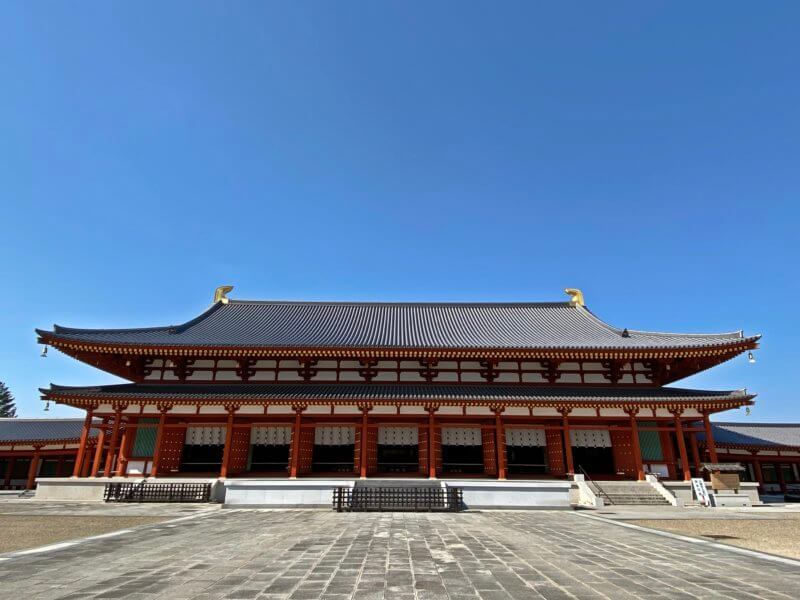
This hall was originally designed to accommodate a number of monks and teach them the doctrine of Buddhism. The interior of the hall consists of white walls and vermilion pillars. If you look up, you will see hundreds of beautiful floral motifs drawn on the ceiling. Above the three large statues, there are three decorative canopies of vivid colors, with arabesques and heavenly maidens depicted on them.
The three large Buddhist statues are collectively called the Miroku Triad. The large ebony-colored statue in the center is Miroku Nyorai. Sanskrit characters are engraved on the round-shaped halo on his back. Two other graceful statues are Bosatsus.
If you go around to the back of the statues, you will find a flat stone in between the statues of ten Buddha followers. It is called the Footprint of the Buddha.
For hundreds of years after the Buddha’s death, carving a Buddha statue was not allowed because there was a belief that a sacred existence should not be reproduced. Instead, they carved his footprint on the stone surface, helping people imagine what the Buddha would look like. This Footprint of the Buddha is said to have been carved in 753 and is the oldest in Japan. Its delicate hairlines are projected on the wall.
Pictures of the Miroku Triad (Official Yakushi-ji website)
https://www.yakushiji.or.jp/en/temples/009.html
East Hall (Toindo)
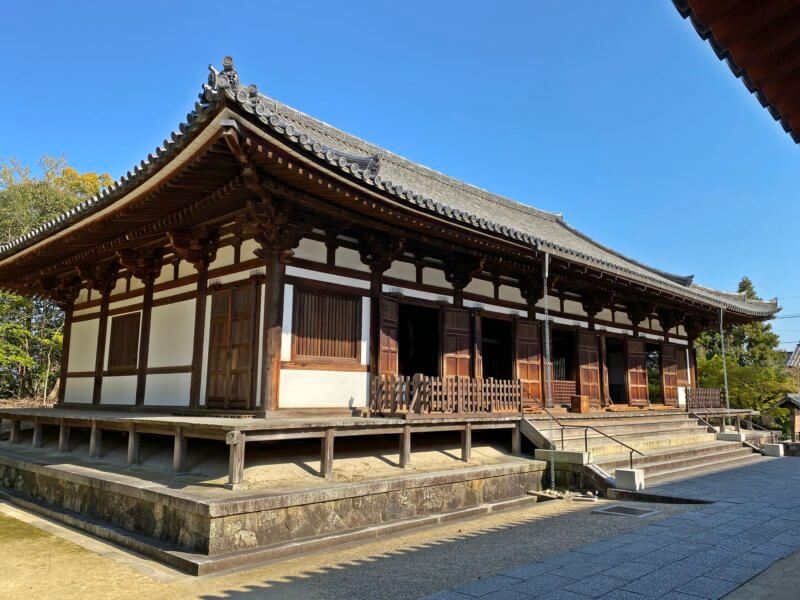
Many visitors to this temple omit this small hall outside the corridor from their tour plan. But you must not miss it! In my opinion, the Bosatsu in this Hall is the most beautiful statue in Yakushi-ji.
The small statue is slender and has a balanced body shape. Above all else, how gentle and graceful his facial expression is! The delicate and thin robe on his body expresses the influence of the culture of the Gupta Empire which existed in India from the fourth to the sixth century.
Both the Hall and the Bosatsu statue are National Treasures.
Pictures of the Bosatsu (Official Yakushi-ji website)
https://www.yakushiji.or.jp/en/temples/013.html
East Pagoda (Toto)
West Pagoda (Saito)

Main Hall and Two Pagodas
The two pagodas symbolize the landscape of Yakushi-ji Temple.
The East Pagoda is said to have been built around 730 and has been there for around 1,300 years, surprisingly. It looks like a six-story building but is actually a three-story pagoda with three decorative pent roofs. Each pent roof is smaller than the roof above, creating a visual rhythm and vibrancy. The form is often described as “Frozen Music.” It is definitely one of the most beautiful pagodas in Japan.
Major repair work on the East Pagoda took more than ten years and was completed in 2021.
The West Pagoda was rebuilt in 1981.
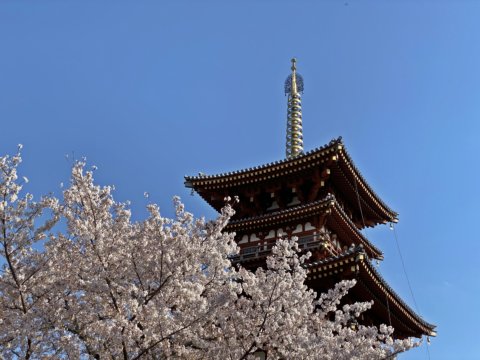
West Pagoda
Jikido Hall
A new modern multi-purpose hall where many large wall paintings are exhibited.
Genjo Sanzo-in Precincts (in the North)
All structures in the precincts were built in 1991.
Xuanzang Pagoda (Genjo-to)
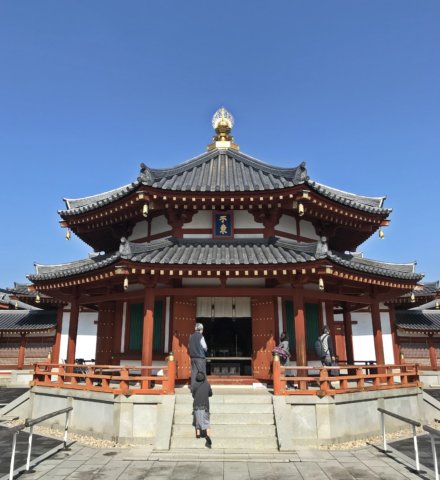
Xuanzang (602 – 664) is a famous Chinese Buddhist priest. He travelled to India to study Buddhism and returned to China with 657 sutras. He translated them into Chinese and thus contributed to the development of Buddhist culture in East Asia.
The two Chinese characters in the picture frame above the entrance to the pagoda mean “I will not return East.” It describes his firm determination that he would never return to China if he could not reach India.
The ashes and statue of Xuanzang are enshrined in the pagoda.
In the building behind the pagoda, a series of huge murals depicting the scenery of the Silk Road by a famous Japanese painter, Ikuo Hirayama, is exhibited.
Information:
Hours:
8:30 to 17:00
* Enter 30 minutes earlier than the closing time .
Admission:
Peak periods*1: Adult: 1,100 yen*2 or 1,600 yen*3
Off-peak periods Adult: 800 yen*4
*1 Peak periods: January 1 to 8, March 1 to June 30, August 13 to 15 and September 16 to November 30
*2 Accessible to Main Hall, Great Lecture Hall, East Hall (Toindo) and Genjo Sanzo-in Precincts.
*3 Also accessible to West Pagoda and Jikido Hall in addition to the above.
*4 Off-peak periods: Periods other than the above. Accessible to Main Hall, Great Lecture Hall and East Hall (Toindo) only.
Address:
457, Nishinokyo-cho, Nara City 630-8563 Japan
* You are always asked to check information on the official website before you visit.
https://www.yakushiji.or.jp/en/
(Official Yakushi-ji website)
Access:
For detailed access information, see the Recommended Route of Nishinokyo Area page.
Last updated: March 19, 2021
Text by: Yumi
Eye-catching photo by giuliettar2